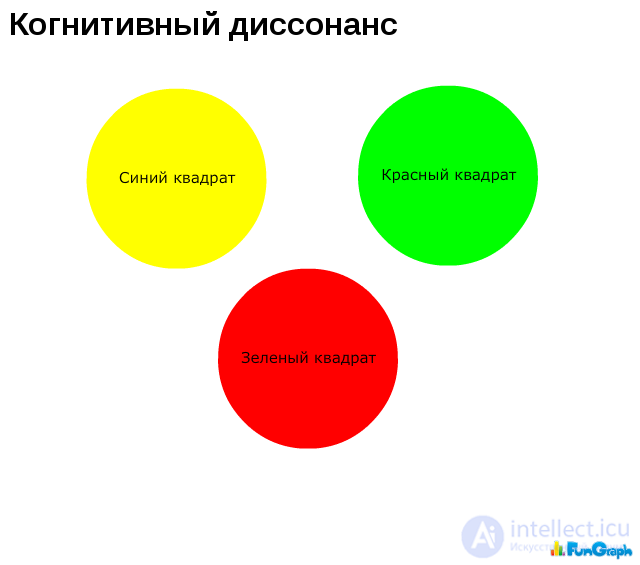Lecture
Cognitive dissonance (from Latin words: cognitio - “ knowledge ” and dissonantia - “ inconsistency, lack of structure, lack of harmony ”) - the state of mental discomfort of the individual, caused by the clash in his mind of conflicting ideas: ideas, beliefs, values or emotional reactions.
The concept was first introduced by Leon Festinger in 1957.
The theory of cognitive dissonance was proposed by Leon Festinger in 1957. It explains conflict situations that often arise "in the cognitive structure of one person" [1] . The theory aims to explain and explore the state of cognitive dissonance that occurs in a person as a reaction to a certain situation, the actions of individuals or the whole society.
Leon Festinger formulates two main hypotheses of his theory:
Dissonance can occur for various reasons [2] :
Cognitive dissonance arises due to the inconsistency between the two cognitions (knowledge) of the individual. The individual, having information on any issue, is sometimes forced to neglect it when making a certain decision. As a result, there is a discrepancy (dissonance) between the attitudes of a person and his real actions. [ source not specified 466 days ]
As a result of this behavior, certain attitudes (to which the situation somehow affects) attitudes of a person change, and this change can be justified on the basis that it is vital for a person to maintain the consistency of his knowledge [3] .
Therefore, people are ready to justify their errors: a person who has committed a misconduct or mistake tends to justify himself in thoughts, gradually shifting his beliefs about what happened in the direction of what is not really so bad. Thus, the individual “regulates” his thinking in order to reduce the conflict within himself [3] .
In various situations that arise in everyday life, dissonance may increase or weaken - it all depends on the problem that stands before a person.
Thus, the degree of dissonance will be minimal if, for example, a person gives money to a beggar on the street, who (as can be seen) does not need much alms. On the contrary, the degree of dissonance will increase many times if a person has a serious exam, and he is not trying to prepare for it [2] .
Dissonance can arise (and occurs) in any situation when a person has to make a choice. Moreover, the degree of dissonance will grow depending on how important this choice is for the individual.
Change your behavior. The existence of dissonance, regardless of the degree of its strength, forces a person to get rid of him completely, and if for some reason it is not yet possible to do so, then he will significantly reduce it. To reduce dissonance, a person can resort to four methods:
Let us explain this with a concrete example. For example, a person is a chain smoker. He receives information about the dangers of smoking from a doctor, a friend, from newspapers or from another source. In accordance with the information received, he will either change his behavior - that is, quit smoking, because he was convinced that it is too harmful to his health, or he may deny that smoking harms his body, try, for example, to find some information about that smoking may be somewhat “useful” (for example, while he smokes, he does not gain weight, as happens when a person quits smoking), and thereby reduce the importance of negative information. This reduces the discord between his knowledge and actions. In the third case, he will try to avoid any information that emphasizes the harm of smoking [1] [2] .
== Preventing dissonance and overcoming it ==
The mechanisms of “filtering” personally significant information for the subject are well described by the theory of “psychological defenses” (the concept was introduced by Sigmund Freud and further developed by his daughter Anna Freud). A “mistake”, a contradiction arising in the mind of an individual with respect to deeply, personally significant topics, is, according to Freud, the main mechanism in the formation of neuroses. In some cases, an individual can prevent the appearance of dissonance (and, as a result, internal discomfort) by that will try to avoid any information regarding their problem, which conflicts with the information already available.
If the dissonance has already arisen, the individual can avoid its amplification by adding one or several cognitive elements “to the cognitive scheme” [2] instead of the existing negative element (which causes dissonance). Thus, the individual will be interested in finding such information that would approve his choice (decision) and, eventually, weaken or completely eliminate the dissonance, while avoiding sources of information that will increase it. However, often this behavior of an individual can lead to negative consequences: a person may have a fear of dissonance or a prejudice, which is a dangerous factor affecting an individual’s worldview [2] .
Between two (or more) cognitive elements there may be a discrepancy (dissonance) relationship. In the event of dissonance, the individual strives to reduce his degree, to avoid or get rid of him completely. This desire is justified by the fact that a person sets as his goal the change of his behavior, the search for new information regarding the situation or the object that gave rise to dissonance [2] .
It is quite understandable that it is much easier for a person to agree with the existing state of affairs, having corrected his internal installations, according to the current situation, instead of continuing to be tormented by the question whether he acted correctly. Often dissonance arises as a consequence of making important decisions. The choice of two equally attractive alternatives is not easy for a person; however, having finally made this choice, a person often begins to feel “dissonant cognitions” [3] , that is, the positive aspects of the option he refused, and not very positive features of what agreed. In order to suppress (weaken) dissonance, a person tries by all means to exaggerate the materiality of the decision made by him, while at the same time diminishing the importance of the rejected. As a result, another alternative loses all attractiveness in his eyes [3] .
Cognitive dissonance is a state characterized by a collision in the human mind of conflicting knowledge, beliefs, behavioral attitudes regarding some object or phenomenon. According to the theory of cognitive dissonance (Leon Festinger), such a state does not suit a person and gives rise to an unconscious desire to make the system of their knowledge and beliefs consistent and consistent.
For example, if I’m afraid of something, but I don’t see anything, I have an internal dissonance. When I found or invented what was right for me to fear, my soul calmed down. See →
Or, if I think I’m a clever person, I’m a fool and I consider myself a clever person, then this is a contradiction. It is eliminated in two ways - either to agree that in this situation I was a fool, or to consider that the fool is the one who called me that. The second is usually nicer.
So, if you willingly or unwittingly helped a person, rendered assistance, you will need to explain yourself after yourself why you did it. Well, not foolish? The simplest explanation that people almost unconsciously find their good deeds: "Because in this person there is something (good) in there." And after that, they treat the person with more benevolence and sympathy. See →
To think about someone is bad and to live far away from him is intrinsically logical. But living next to a very bad person is a little logical, and people try not to live next to such a person. However, if the joint life is inevitable and you cannot get away from it at all, then maybe it is not so bad, but just so special? See →
Cognitive dissonance is a mild version of intrapersonal conflict. See intrapersonal conflict.


Comments
To leave a comment
General psychology
Terms: General psychology